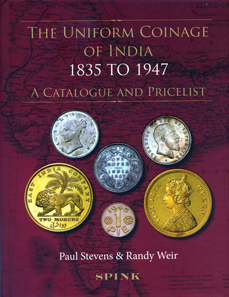by Ursula Kampmann
November 7, 2013 – In 1835, eventually, a common coinage was introduced in British-dominated India. This coinage was based on the silver rupee weighing 180 grains with a fineness of 11/12 silver. James Prinsep (1799-1840) was responsible of this reform. Starting his career as assay master of the Calcutta Mint he succeeded in bringing finally to a positive conclusion negotiations which had lasted over forty years. Unfortunately we cannot dedicate us more in detail to the life of this man who was of such a relevance to numismatics and who published numerous books on India’s ancient coins establishing himself as one of the founding fathers of Indian numismatics.
Paul Stevens, Randy Weir, The Uniform Coinage of India 1835 to 1947. A Catalogue and Pricelist. Spink, London, 2012. 374 p., images and plates in colour. 25.3 x 19.2 cm. Hardcover. ISBN: 978-1-907427-237-7. 75 GBP.
Instead we will treat the new reference work written by Paul Stevens and Randy Weir on the Uniform Coinage of India between 1835 and 1947 and published with Spink. It is indeed a reference work, a catalogue with the main goal of assisting in describing the coins. At the same time it is much more, though, since the authors did intense research on the background of every single coin type as far as possible by reviewing the documents.
The material is organised and presented according to rulers and for every ruler in periods and then denominations in decreasing order. To explain the catalogue’s structure let’s inspect an example, the 1862 rupee. You can tell quite a lot about this special coin. Did you know that the dies manufactured by Wyon in London could not be used due to technical reasons? The authors explain also the significance of the pearls which are generally shown on the reverse below the year of issue. They indicate the actual year of production which can differ from the date on the die. Giving a glance into the history of research of this type of rupee shows that the authors had to deal with quite a big number of variations. They were able to list more than 50 variations and are convinced that in future even more may come to light. Of this special type over half a billion (!) pieces was minted, anyway.
Following this introduction a particularly fine specimen of that issue is reproduced in enlarged dimension and described. In a box all technical data are given like weight, size and die position. Beside that a circle shows the coin’s actual size.
Then come the minting numbers – sub-divided according to the various mints. The heart of this section are excellent blow-ups of those parts of the coins which help distinguishing different types. Finally all these types are neatly listed in a catalogue and graded in three preservations.
Of course not all pieces need to be dealt so extensively with, however the authors strive for being comprehensive and they do this indeed with admirable consistency.
The book concludes with concordances of the previous reference works and a couple of magnificent plates showing very particular coins.
All those who collect or sell Indian coins must buy this book. And mind that there are different editions: hardcover, paperback, and for those who use it every day wire-o bound!





